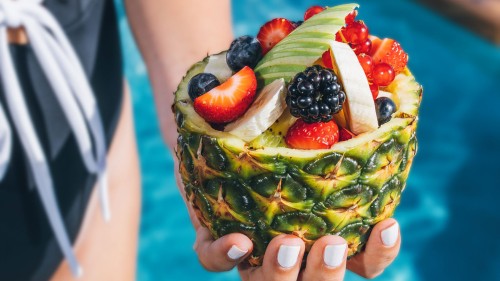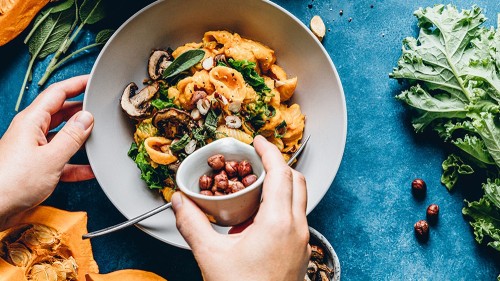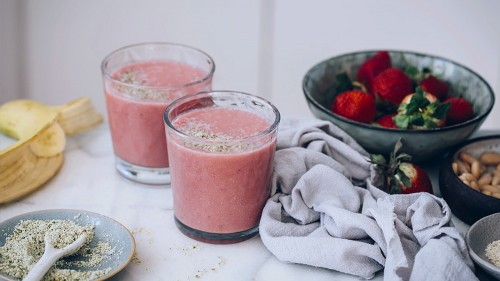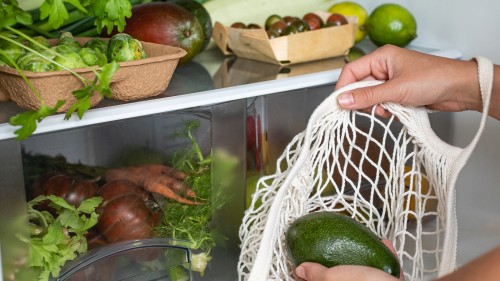A Dietitian Shares 10 Best Plant-Based Protein Sources and Ways to Use Them
Last Updated on September 29, 2023
Medically Reviewed by Anthony Dugarte, MD
If you’re shifting towards a plant-based lifestyle, you can meet your protein needs by incorporating these high-quality vegetarian protein sources into your diet. Here are the best sources and ways to use them.

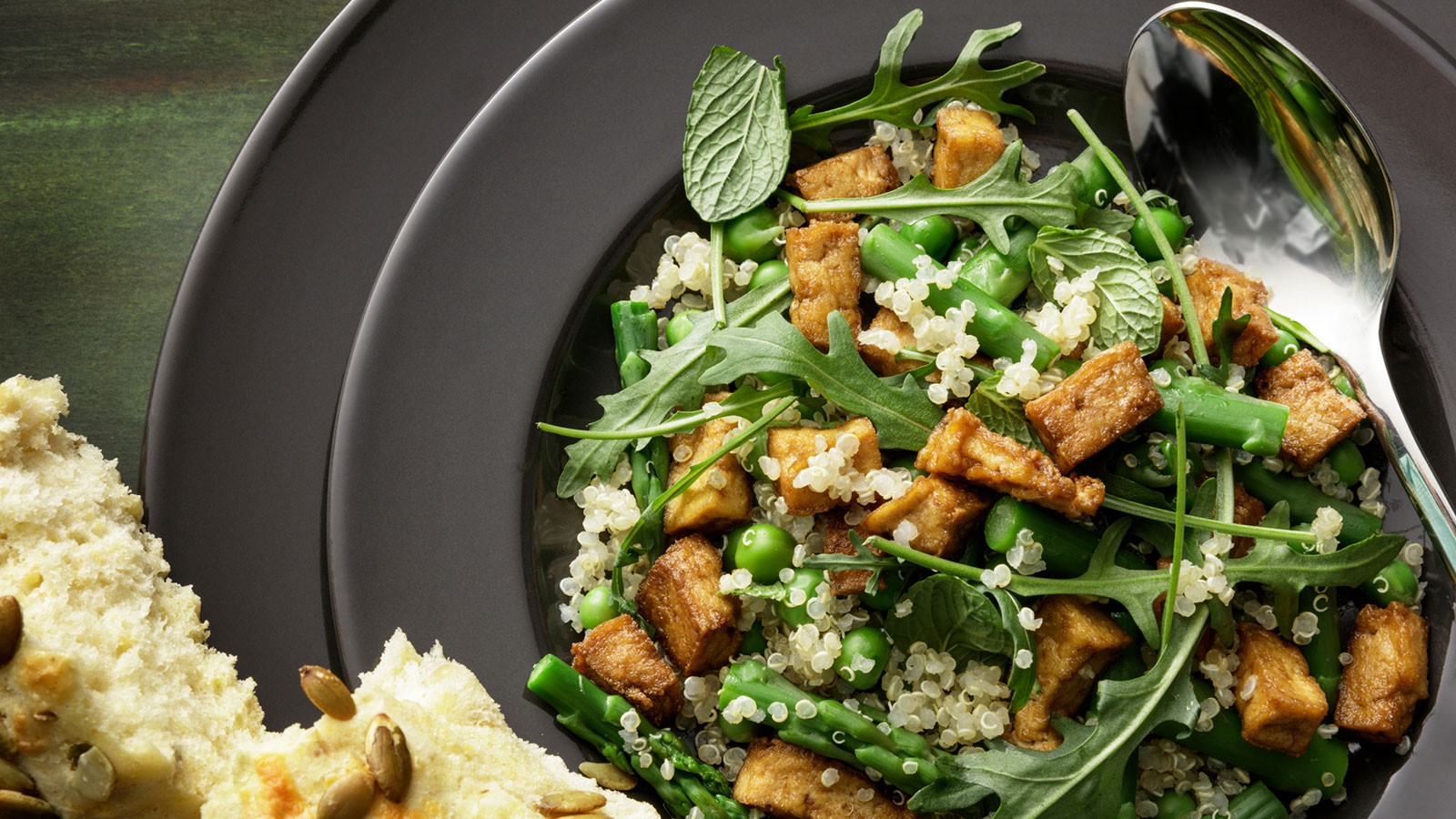
Many people are shifting away from animal products and moving towards eating a plant-based diet.
If you’re following a vegetarian or vegan diet, you may be wondering if you’re getting enough protein.
A well-balanced vegetarian or vegan diet can provide adequate nutrients, including high-quality, plant-based protein sources to meet your nutritional needs.
In fact, according to the Academy of Nutrition and Dietetics, a vegetarian or vegan diet can provide all of the nutritional requirements for all stages of life. (1) This includes pregnancy, lactation, infancy, childhood, adolescence, and older adulthood. And it is suitable for athletes.
The following are ten of my favorite plant-based protein sources:
1. Tempeh
Protein amount: 16 grams per 3 ounces (2)
Tempeh is a soy-based product made by fermenting cooked soybeans and forming the mixture into firm, dense cake-like strips.
Most tempeh will also contain beans, grains, and flavorings.
Because tempeh is made from soy, and soybeans are considered a whole source of protein, tempeh will provide your body with all nine essential amino acids it needs.
Put It Into Action:
- If you’ve never tried tempeh, don’t be intimidated. It’s a versatile choice that tends to absorb the flavors of any food or sauce to which it is added.
- Try making a sandwich with it, adding it to your salad, tossing it into a stir fry, or cooking it into a chili or stew.
2. Black Beans
Protein amount: 14 grams per 1 cup (3)
Not only do black beans provide an excellent vegetarian source of protein, but they are packed with fiber, iron, folate, and magnesium.
Black beans may also help reduce blood sugar spikes as they have a lower glycemic index than other high-carbohydrate foods. This may help with weight management and reduce the risk of diabetes.
Put It Into Action:
- Besides adding them to salads, tacos, and soups, black beans can be incorporated into various dishes in some surprising ways.
- Black beans can be whipped into a side dish as an alternative to mashed potatoes.
- To include more fiber in your breakfast meal, try adding black beans to your favorite egg dish.
- And perhaps most surprisingly, black beans also can be swapped for flour in your favorite brownie recipe, which will create a dense, fudgy brownie that’s lower in calories and higher in fiber.
3. Lentils
Protein amount: 9 grams per 1/2 cup (4)
Whether you are vegan, vegetarian, or just looking to reduce your meat intake, lentils are budget-friendly and a healthy source of plant-based protein.
Lentils are an excellent protein source, but they are also loaded with fiber, vitamins, minerals, and beneficial plant compounds called phytochemicals.
These antioxidant-rich phytochemicals provide many health benefits and have been shown in studies to have anti-obesity, anti-cancer, anti-inflammatory, and anti-diabetes properties. (5)
Put It Into Action:
- Lentils can be added to soups and stews to provide more protein and fiber.
- They’re also great for substituting in recipes that usually use ground meat as they will absorb flavors easily and are similar in size and texture.
4. Edamame
Protein amount: 9 grams per 1/2 cup (6)
Edamame beans are whole, immature soybeans.
Unlike many plant proteins, edamame beans are considered a whole protein source as they will provide all the essential amino acids your body needs.
In addition to protein, edamame also provides a host of other vitamins and minerals, including folate, vitamin K, B vitamins, and manganese.
Put It Into Action:
- Edamame is delicious when eaten on its own like a snack and can be seasoned with some salt and garlic powder.
- You can use edamame the same way you would any other bean by mashing it into a puree and making it a tasty dip.
- These versatile beans can also be added to stir-fry, salads, or thrown into your favorite veggie burger recipe.
5. Almonds
Protein amount: 9 grams per 1.5 ounces (7)
These delicious nuts are packed with plant-based protein and loaded with fiber, heart-healthy fats, vitamin E, magnesium, manganese, and antioxidants.
Antioxidants have been shown to slow the aging process, reduce the risk of heart disease, and even reduce the risk of some cancers. (8)
The thin brown layer of skin is home to the highest concentration of antioxidants, so be sure to eat almonds with the skin to reap these health benefits.
Put It Into Action:
- Almonds can be enjoyed as a snack but can also be added to your yogurt or oatmeal.
- They can also be blended into a smoothie or used as a crunchy topper in your favorite salad.
6. Tofu
Protein amount: 8 grams per 3 ounces (9)
Tofu is made by coagulating soy milk to create curds. These curds are then compressed into the white blocks known as tofu.
It is an essential complete protein source, particularly for vegans and vegetarians, as it contains all nine essential amino acids.
Not only is tofu high in protein, but it also provides a wide variety of vitamins and minerals.
There is some controversy surrounding the consumption of soy products, especially for women who have had breast cancer.
However, According to the American Cancer Society, the evidence does not show any danger in eating soy for women with breast cancer. (10)
In fact, there is emerging research showing that eating soy foods may actually lower the risk of breast cancer.
Put It Into Action:
- Extra-firm and firm tofu will retain its shape when cooked and is an excellent product for grilling and stir-frying.
- Soft and silken tofu is easily pureed and can be blended into soups or smoothies.
7. Quinoa
Protein amount: 8 grams per 1 cup (11)
Often considered a superfood, quinoa contains more protein, fiber, vitamins, minerals, and healthy fats than most other grains.
Quinoa is an ideal protein source for vegans and vegetarians because it contains all nine essential amino acids.
It’s also very high in beneficial plant compounds that can act as antioxidants, which can protect your body from harmful free radicals.
Put It Into Action:
- This versatile little grain is an excellent alternative to pasta or rice.
- Quinoa also makes an ideal base for a delicious and filling grain salad.
8. Nutritional Yeast
Protein amount: 8 grams per 1/4 cup (12)
Nutritional yeast is typically sold as flakes, granules, or powder and can be found in the spice section or bulk section of many health food stores.
This popular food product is often a staple among many people following a plant-based diet and is a powerhouse of nutritional goodness.
Not only is it a complete protein providing all nine essential amino acids, but it also provides powerful antioxidants and is an excellent source of B vitamins, especially B12.
Vitamin B12 is typically found in animal products, so people following a vegan diet are encouraged to supplement B12 to avoid a deficiency.
Therefore, including nutritional yeast can help to prevent a B12 deficiency while following a vegan diet.
Put It Into Action:
- Nutritional yeast can be stirred into soups or sprinkled over popcorn.
- It can also be added as a “cheese” flavoring in vegan sauces.
9. Sprouted-Grain Bread
Protein amount: 5 grams per 1 slice (13)
It may come as a surprise, but sprouted-grain bread will offer a decent amount of protein for vegetarians and vegans alike.
Sprouted grain bread is typically derived from a variety of whole grains and legumes, including soybeans and lentils.
Combining these various grains with legumes makes the protein in sprouted grain bread complete, meaning that it includes all of the essential amino acids.
This nutrient-dense bread provides protein and fiber, making it a healthier option than white bread.
Put It Into Action:
- Most sprouted grain bread can be found in health food stores or a conventional grocery store’s refrigerator or freezer section.
- Sprouted grain bread tends to be denser than bread made from flours, sometimes making its texture an acquired taste.
- However, toasting the bread will modify the texture making it more appealing for people accustomed to traditional bread.
10. Green Peas
Protein amount: 4 grams per 1/2 cup (14)
Green peas may be small, but they have an impressive nutrition profile.
These little peas are unique from other vegetables because they have a higher protein content at 4 grams per 1/2 cup.
One serving of green peas also provides more than 25% of your daily fiber, vitamin A, C, K, thiamine, folate, and manganese requirements.
Put It Into Action:
- Peas are so easy to add to any side or main dish.
- Try adding peas to your cooked rice or quinoa to make a pilaf. Mix peas in a stir fry or add them to your favorite pasta primavera recipe.
- Peas can also make an excellent addition to your green salad.
FAQs
How Much Protein Do You Need?
According to the Dietary Reference Intake (DRI) for macronutrients, a sedentary adult should consume 0.8 grams of protein per kilogram of body weight or 0.36 grams per pound. (15)
For example, one kilogram equals 2.2 pounds, so a person who weighs 150 pounds, or 68 kg, would need roughly 55 grams of protein per day.
However, your protein will likely increase if you are very active.
The Academy of Nutrition and Dietetics, Dietitians of Canada, and the American College of Sports Medicine recommend approximately 1.2 to 2.0 grams of protein per kilogram of body weight per day for athletes. (16)
What Is the Difference Between Animal Protein and Plant-Based Protein?
Proteins are made up of 20 different types of amino acids. Your body cannot produce 9 of these 20 acids, so they are called essential amino acids.
A complete protein source means that the type of food contains all nine essential amino acids.
Many animal products like red meat, chicken, fish, and eggs are complete sources of protein.
Many plant proteins are incomplete, meaning they are missing at least one of the essential amino acids.
If following a plant-based diet, you will want to eat a variety of plant proteins throughout the day to make sure you get all of the essential amino acids your body needs.
What Are the Potential Benefits of Plant-Based Proteins?
Including plant-based proteins in your diet can have far-reaching benefits for not only your health but also for the planet.
Plant proteins are naturally lower in calories than animal proteins, and they also provide many vital nutrients, including fiber, antioxidants, healthy fats, potassium, and magnesium.
- Can Assist with Weight Management: Plant proteins tend to be low in calories and also provide fiber. This combination may help contribute to weight loss. One 2016 review of 12 randomized controlled trials found that vegetarian diets had significant benefits on weight reduction compared to non-vegetarian diets. (17)
- Promotes Heart Health: Many studies have linked red meat intake with an increased risk of heart disease. (18) One 2019 study found that plant-based diets had the most positive effects on LDL (“bad”) cholesterol levels among diets with red meat, white meat, and plants. (19)
- Helps the Environment: Making the switch from meat to plant proteins can also be less taxing on the environment. One 2018 study suggested that producing plant protein typically requires less land, water, and energy than producing animal protein. (20) Moreover, plant protein production results in lower levels of greenhouse gas emissions (GHGEs) compared to raising animals.
Are There Other Nutrients to Consider on a Plant-Based Diet?
While protein is an essential nutrient to consider when following a vegan or vegetarian diet, there are some other nutrients that you’ll want to make sure you’re getting sufficient amounts of.
These nutrients include:
- Calcium
- Vitamin D
- Iron
- Zinc
- Vitamin B12
- Omega-3 fatty acids
The Bottom Line
You may be wondering how to get protein as a vegetarian or a vegan. As you can see, protein sources aren’t limited to meat, fish, and poultry.
A well-planned vegetarian or vegan diet that includes a variety of foods can provide you with all the nutrients you need.
Additionally, shifting away from animal proteins and adding more plant proteins to your diet appears to have far-reaching health benefits.
At WellnessVerge, we only use reputable sources, including peer-reviewed medical journals and well-respected academic institutions.
- Position of the Academy of Nutrition and Dietetics: Vegetarian Diets:
https://pubmed.ncbi.nlm.nih.gov/27886704/ - Agricultural Research Service, FoodData Central: TEMPEH:
https://fdc.nal.usda.gov/fdc-app.html#/food-details/365644/nutrients - Agricultural Research Service, FoodData Central: Black Beans:
https://fdc.nal.usda.gov/fdc-app.html#/food-details/626716/nutrients - Agricultural Research Service, FoodData Central: Lentils, mature seeds, cooked, boiled, without salt:
https://fdc.nal.usda.gov/fdc-app.html#/food-details/172421/nutrients - Polyphenol-Rich Lentils and Their Health Promoting Effects:
https://pubmed.ncbi.nlm.nih.gov/29125587/ - Agricultural Research Service, FoodData Central: Edamame, frozen, prepared:
https://fdc.nal.usda.gov/fdc-app.html#/food-details/168411/nutrients - Agricultural Research Service, FoodData Central: Nuts, almonds:
https://fdc.nal.usda.gov/fdc-app.html#/food-details/170567/nutrients - The phytochemical composition and antioxidant actions of tree nuts:
https://www.ncbi.nlm.nih.gov/pmc/articles/PMC5012104/ - Agricultural Research Service, FoodData Central: Vitasoy USA Organic Nasoya, Soft Tofu:
https://fdc.nal.usda.gov/fdc-app.html#/food-details/173783/nutrients - Soy and Cancer Risk: Our Expert’s Advice:
https://www.cancer.org/latest-news/soy-and-cancer-risk-our-experts-advice.html - Agricultural Research Service, FoodData Central: Quinoa, cooked:
https://fdc.nal.usda.gov/fdc-app.html#/food-details/168917/nutrients - Agricultural Research Service, FoodData Central: NUTRITIONAL YEAST:
https://fdc.nal.usda.gov/fdc-app.html#/food-details/1991802/nutrients - Agricultural Research Service, FoodData Central: SPROUTED GRAIN BREAD:
https://fdc.nal.usda.gov/fdc-app.html#/food-details/1856296/nutrients - Agricultural Research Service, FoodData Central: Peas, green, canned, regular pack, solids and liquids:
https://fdc.nal.usda.gov/fdc-app.html#/food-details/170421/nutrients - Nutrient Recommendations: Dietary Reference Intakes (DRI):
https://ods.od.nih.gov/HealthInformation/Dietary_Reference_Intakes.aspx - Protein and the Athlete — How Much Do You Need?:
https://www.eatright.org/fitness/sports-and-performance/fueling-your-workout/protein-and-the-athlete - Vegetarian Diets and Weight Reduction: a Meta-Analysis of Randomized Controlled Trials:
https://pubmed.ncbi.nlm.nih.gov/26138004/ - Higher consumption of red and processed meat is associated with adverse cardiovascular magnetic resonance morpho-functional phenotypes: A study of 19,408 UK Biobank participants:
https://academic.oup.com/eurjpc/article/28/Supplement_1/zwab061.454/6274098 - Effects of red meat, white meat, and nonmeat protein sources on atherogenic lipoprotein measures in the context of low compared with high saturated fat intake: a randomized controlled trial:
https://academic.oup.com/ajcn/article/110/1/24/5494812?login=true - Plant-Based Diets: Considerations for Environmental Impact, Protein Quality, and Exercise Performance:
https://www.ncbi.nlm.nih.gov/pmc/articles/PMC6316289/

